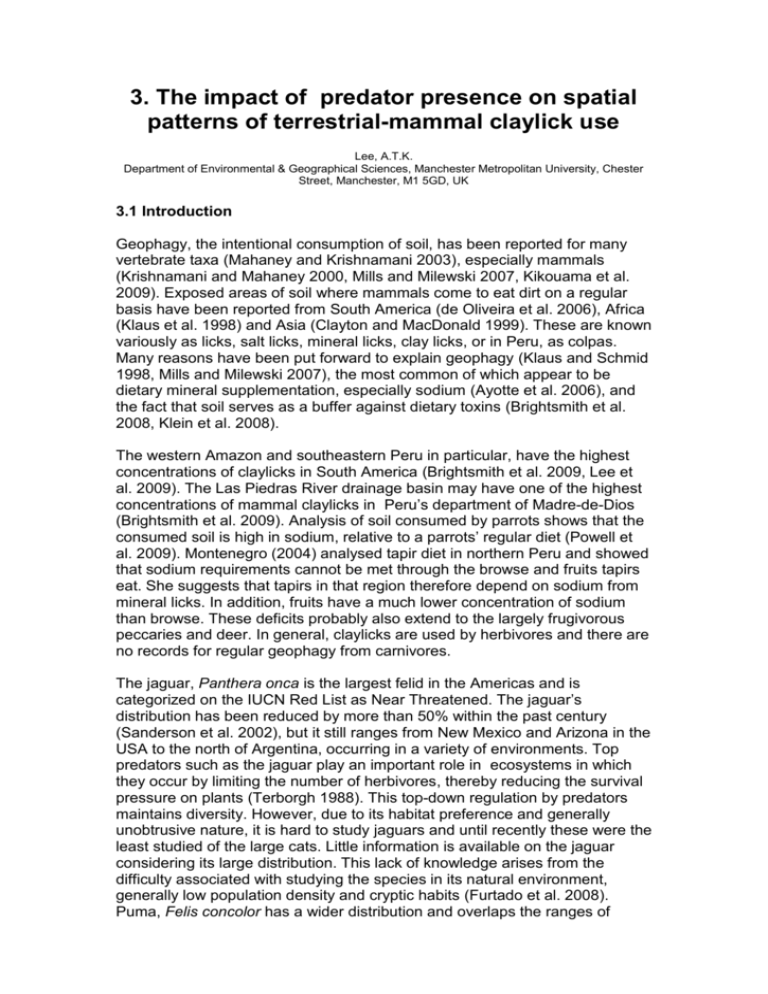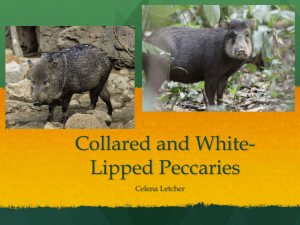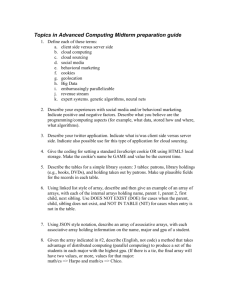The Impact of Predator Presence on Mammal Clay Licks
advertisement

3. The impact of predator presence on spatial patterns of terrestrial-mammal claylick use Lee, A.T.K. Department of Environmental & Geographical Sciences, Manchester Metropolitan University, Chester Street, Manchester, M1 5GD, UK 3.1 Introduction Geophagy, the intentional consumption of soil, has been reported for many vertebrate taxa (Mahaney and Krishnamani 2003), especially mammals (Krishnamani and Mahaney 2000, Mills and Milewski 2007, Kikouama et al. 2009). Exposed areas of soil where mammals come to eat dirt on a regular basis have been reported from South America (de Oliveira et al. 2006), Africa (Klaus et al. 1998) and Asia (Clayton and MacDonald 1999). These are known variously as licks, salt licks, mineral licks, clay licks, or in Peru, as colpas. Many reasons have been put forward to explain geophagy (Klaus and Schmid 1998, Mills and Milewski 2007), the most common of which appear to be dietary mineral supplementation, especially sodium (Ayotte et al. 2006), and the fact that soil serves as a buffer against dietary toxins (Brightsmith et al. 2008, Klein et al. 2008). The western Amazon and southeastern Peru in particular, have the highest concentrations of claylicks in South America (Brightsmith et al. 2009, Lee et al. 2009). The Las Piedras River drainage basin may have one of the highest concentrations of mammal claylicks in Peru’s department of Madre-de-Dios (Brightsmith et al. 2009). Analysis of soil consumed by parrots shows that the consumed soil is high in sodium, relative to a parrots’ regular diet (Powell et al. 2009). Montenegro (2004) analysed tapir diet in northern Peru and showed that sodium requirements cannot be met through the browse and fruits tapirs eat. She suggests that tapirs in that region therefore depend on sodium from mineral licks. In addition, fruits have a much lower concentration of sodium than browse. These deficits probably also extend to the largely frugivorous peccaries and deer. In general, claylicks are used by herbivores and there are no records for regular geophagy from carnivores. The jaguar, Panthera onca is the largest felid in the Americas and is categorized on the IUCN Red List as Near Threatened. The jaguar’s distribution has been reduced by more than 50% within the past century (Sanderson et al. 2002), but it still ranges from New Mexico and Arizona in the USA to the north of Argentina, occurring in a variety of environments. Top predators such as the jaguar play an important role in ecosystems in which they occur by limiting the number of herbivores, thereby reducing the survival pressure on plants (Terborgh 1988). This top-down regulation by predators maintains diversity. However, due to its habitat preference and generally unobtrusive nature, it is hard to study jaguars and until recently these were the least studied of the large cats. Little information is available on the jaguar considering its large distribution. This lack of knowledge arises from the difficulty associated with studying the species in its natural environment, generally low population density and cryptic habits (Furtado et al. 2008). Puma, Felis concolor has a wider distribution and overlaps the ranges of jaguar extensively. However, where they overlap, spatial, temporal and dietary partitioning is usually observed (Novack et al. 2005). In Brazil, white-lipped peccary, Tayassu pecari closely followed by jaguar, preferred Buritizal forests; whereas collared peccary Tayassu tajacu, followed by puma exploited the other available high-ground forest types (Pontes and Chivers 2007). Fluctuations in food supply regulated the dynamics of the two species of peccaries, which ultimately determined the whereabouts of the large cat predators (Pontes and Chivers 2007). The presence of a claylick can influence spatial patterns of distribution of its users (Holdo et al. 2002, Bravo et al. 2008). As a consequence, human hunters in Peru are known to visit claylicks on their hunting excursions (Montenegro 2004). Whether the same is true of large cats has not been shown to date, although radio-tracking fixes of female jaguars in Brazil suggested a pattern of spatial avoidance among females during the wet season (Cavalcanti and Gese 2009). With predation risk, prey species greatly restrict their use of available habitats and consumption of available food resources, therefore the presence of top predators consequently cascades down to the trophic levels below them (Ale and Whelan 2008). Human hunting, while known to decimate populations with overharvesting, is potentially a sustainable activity if managed (Bodmer et al. 1997). However, little is known as to the effects on mammal spatial use patterns, from hunting at a claylick. One study found that from a selection of local hunters, 70% preferred hunting at a claylick due to the reliability of attracting prey, with the most hunted being white-lipped peccary, making up 55% of overall hunting (Montenegro, 2004). Objectives 1. Use track trap arrays to compare terrestrial mammal species richness and abundance, at sites with and without claylicks. 2. Ascertain levels of cat or human (hunting) presence and the extent to which this causes any differences in herbivore presence. 3.2 Methods The Biosphere Expedition study site was the concession areas associated with the Las Piedras Biodiversity Station (LPBS), (Figure 3.2a). The concession area has two large mammal claylicks, one of which is 2.7km from the study base. Previous observations here have confirmed the presence of the four large ungulate species: tapir, white-lipped peccary, collared peccary and red-brocket deer; and also various rodents including paca, brown agouti and green acouchy (described in Hammer and Tatum-Hume 2003). The first survey was conducted from 6 November 2009 to 4 December 2009. The second survey was conducted from 13 to 28 June 2011. In order to record track presence, two arrays of seven parallel access lines of 300m length and spaced 50m apart were created (Figure 1). The first array created (COLPA) was located so that the centre of the array was on a known mammal claylick. The second array (CONTROL) was located less than 1km east on the same stream that ran through the claylick array. Before the location of the second array was chosen, extensive surveys were conducted to ensure no large mammal claylick existed within this array. Figure 3.2a. Map of the concession area on the Las Piedras River, indicating the location of the track traps (purple diamonds) and track trap arrays (clusters of green dots, colpa on the left, control on the right). Access lines were cut in a grid system and avoided the use of existing trails wherever possible, as cats and other species are known to use these. Track traps were arranged in each trail, spaced 50m apart. Each array took one day to cut access lines, with the help of six people, plus additional man-power to mark and measure. A second day was generally needed to create the track traps (49 per array). To remake track traps in 2011, a day was needed for each array. Each track trap in each array was then checked every second day, weather allowing (arrays were checked after at least 24 hours with no rain). Tracks were identified to species level when possible. The Madwi study site encompasses the trail system of the lower Tambopata ecotourism lodge, Posada Amazonas (PAL). The trail system includes four claylicks; two of which are within 1km of the main lodge and used by both parrot species and mammals. Two more are located 3.7km away from the main lodge, clustered to within 100m of each other. Here we monitor red brocket deer, red howler monkey, collared peccary, white-lipped peccary, agouti and tapir. Data for this comparison is taken from November 2010 and June 2011, in order to provide adequate monthyly comparisons with data from previous Biosphere expeditions. Methods used are slightly different, with a grid of 400 by 300 meters, with one 1x1m trap placed randomly within every 100 meters (figure 3.2c). Our COLPA array covers the two large mammal claylicks, while our CONTROL is placed approximately 1km away from the main lodge at a site with a minimum distance of 1.8km to the nearest claylick. Figure 3.2b. Map of the trail system of Posada amazonas Lodge (PAL), indicating the locations of the track trap arrays (purple grids) and claylicks (green spots). Figure 3.2c. Diagram representing formation of trapping grids used at PAL. Not to scale. 3.3 Results Biosphere results from 2009 were based on four days at each array, being the period from 19 November to 3 December. To compare between surveys, four random days were selected for each array for the 2011 survey; giving a total of 196 checks for each of the Biosphere arrays. Posada traps were checked every 2 days, on 4 occasions each month; leading to a total of 128 checks for each array during each of our selected data sets.. LPBS data from 2009 gives a recorded ninety tracks of target species that could be identified, compared to 136 during 2011. A large number of palewinged trumpeter, tinamou species, tortoise and small rodent tracks were also registered, but will not be considered further here. Mean numbers of tracks registered per day per array (excluding non-target species) were 19 for the colpa and 12 for the control during 2009; while it was higher at 29 for the control during 2011, with 21 for the colpa. Species that use the claylick were encountered more than three times as often in the colpa array (Table 3.3a) during 2009, with the most commonly recorded species being white-lipped peccary, which was registered exclusively in the colpa array. Paca, the second highest registration, was also recorded 2.5 times more often in the colpa array. The only claylick user to be recorded in the control array that was not recorded in the colpa array was tapir. Anecdotally, tapir use the mammal claylick very rarely. Ocelot was the most common non-claylick user recorded and was the species with the highest number of registrations in the control array. Jaguar was recorded on only one occasion, in the colpa array. During 2011, more species were recorded in the control matrix and this accounted for both species that use claylicks as well as those that don’t. The number of cat tracks was substantially higher during 2011, accounting for 44% of all tracks. White-lipped peccary were recorded less frequently between surveys, although red-brocket deer was recorded more often. Table 3.3a: Total number of registrations of tracks in two track trap arrays, for four trap days each. Species are subdivided into those that have been recorded eating soil at claylicks during previous observations (Hammer and Tatum-Hume 2003) and those that have not. Species Claylick users: Brown agouti Green acouchy Paca Tapir Red brocket deer Collared peccary White-lipped peccary Claylick user subtotal: Non-claylick users: Armadillo Grey brocket deer Giant anteater Giant armadillo Jaguar Puma Ocelot Non-claylick subtotal: Total: 2009 Colpa 2011 Colpa Total Control Control 2 2 10 0 1 4 17 2 1 4 1 1 4 0 4 3 14 1 2 8 17 4 3 15 36 13 3 6 1 0 1 0 8 19 62 Total 3 2 6 6 7 10 1 7 9 3 10 10 25 1 10 11 9 49 33 43 76 4 3 1 2 0 0 5 7 9 2 2 1 0 13 3 0 2 1 4 3 11 3 0 0 0 23 4 15 6 0 2 0 27 7 26 15 28 34 90 24 48 45 90 68 136 During 2009 the camera trap placed on the mammal claylick recorded no cat activity, compared to jaguar, puma and ocelot being recorded during 2011 (for photos see Appendix 3.1). Multiple jaguar photos and encounters allowed us to identify three individuals (Appendix 3.2). A summary of encounters with those individuals by date and other significant encounters are listed in Table 3.3b. Table 3.3b. Records of jaguars (Female, Jerry, Matthias) from camera traps, and other auspicious jaguar encounters, during the course of the June 2011 survey. Date FEMALE JERRY MATTHIAS UNKNOWN 14/06/11 1 1 17/06/11 1 19/06/11 1 1 20/06/11 1 21/06/11 2 22/06/11 1 23/06/11 1 24/06/11 1 Jiri encounters and photos the female and Jiri at the mammal colpa (see diary) 27/06/11 1 1 Alan, Thomas and Connie encounter all three jaguars on the mammal colpa trail. The battle of the males is overheard (see diary). 29/06/11 2 During 2009, the highest number of registrations of species that are known to feed at claylicks, was recorded at the track traps located in close proximity to the mammal claylick (Figure 3.3b). On no occasion was more than one set of tracks of claylick-using species found in the control, despite habitat and trail variables being similar. However, in 2011 there is no clear pattern between records of animals in track traps between matrix locations. Although a higher number of cat sign were recorded in the control matrix, the ranges of the large cats would typically encompass the colpa as well as the control matrix, given these locations were less than one kilometre apart. The very high number of jaguar encounters can be explained by the presence of a female in heat. The jaguar known as Matthias had been recorded previously using the main trail (Brazil Nut trail) through the concession area, as well as the presence of a second male jaguar (Mazzolli 2009). It is presumed that this is not a coalition as observed with lions, but rather an indication that the ecotourism concession is more likely the boundary between two resident jaguars. The presence of the female jaguar in heat undoubtedly resulted in greater activity of the resident jaguars. Figure 3.3c: The number of encounters at two track trap arrays, COLPA and CONTROL, for two sampling periods: 2009 and 2011. The top section shows cumulative scores for any species known to use a claylick, while the lower section shows track traps where jaguar or puma presence was recorded. Grid reference 150, 150 represents the location of the mammal claylick in the colpa array. Results represent cumulative results from four survey days at each array. Posada data from 2010 wet season gives 56 records of target species, compared to 48 in 2011 dry season. Mean number of tracks per day for each array were 8 for the colpa and 7 for the control in 2010; while results for the colpa in 2011 were the same, with an average per day of 8, but lower for the control with an average of 6. During 2010 wet season, species that are known claylick users were found almost as frequently in the control array, while in 2011 dry season this difference is stronger, with a 60% increase from control number frequencies recorded at the claylick (table 3.3d). White-lipped peccary are the most frequently recorded species at the control array in 2010 and at the claylick in 2011. Collared peccary, the second most recorded, was overall seen almost twice as frequently in the claylick array. Red brocket deer were recorded almost exclusively at the claylick array during wet season 2010, while seen equally at both the claylick and control array during dry season 2011. Tapir was almost exclusively seen at the claylick during both data sets, only being recorded at the control twice in dry season 2011. Brown agouti were regularly seen more frequently at the control, over twice as frequently in the wet season 2010 data, and only slightly more during 2011. Non-claylick users appear to pass through the grids by chance and extremely infrequently, with only the ocelot and giant armadillo being recorded more than once. From our wet season study in 2010 to our dry season 2011 study, numbers of track recordings remain similar, excluding brown agouti which shows a 50% drop. White-lipped peccary records show the biggest difference between colpa and control arrays, with almost inverse numbers being recorded between the two data sets. Tapir favours the colpa array, only being found in the control twice during 2011. Red brocket deer also favour the colpa array in 2010, though found equally between arrays in 2011. Brown agouti appears to favour the control, being found there over twice as frequently in 2010. Table 3.3d: Total track registrations in Colpa and Control track trap arrays, for four trap days each. Species are subdivided into those that are known claylick consumers, and those that are not. 2010 2011 Species colpa control Total colpa control Total Claylick users: Brown agouti 3 7 10 2 3 5 Tapir 8 8 4 2 6 Red brocket deer 6 1 7 4 4 8 Collared peccary 8 4 12 6 4 10 White-lipped peccary 5 14 19 13 6 19 Claylick user subtotal: 30 26 56 29 19 48 Non-claylick users: Armadillo 1 1 0 Giant anteater 0 1 1 Giant armadillo 1 1 2 2 Jaguar 0 1 1 Ocelot 1 1 2 2 Non-claylick subtotal: 2 1 3 3 3 6 Total: 32 27 59 32 22 172 During 2011, the highest records of claylick feeders were recorded at the colpa array, with notably more encounters than at the control. During 2010, numbers show less differentiation between the two sites, with higher overall numbers of recordings than 2011. During the wet season data set (2010), a number of signs of human hunting activity were noted during visits to the Colpa array. As well as shoe prints being found in the area (including type “tennis”, which were never worn by project members), gun cartridges were found twice. On one occasion two white-lipped peccary heads were found in the middle of one of the claylicks, with no other bones or body parts present. Upon taking to the staff at Posada, the majority of which are from the local community; it was found that it was common practice for human hunters to cut off and leave the heads of hunted animals, pointing to human rather than natural hunting occurrence. Figure 3.3e: The number of encounters at the Posada (PAL) track trap arrays, COLPA and CONTROL; for wet season 2009 and dry season 2011. Numbers show culmulative records for only claylick users. D 300 and B 100 are approximate claylick locations within the Colpa array. Results represent cumulative results from four survey days at each array. 2010 2011 Occurrence of claylick users (agouti, tapir, red brocket deer and peccaries) COLPA 400 300 CONTROL 2 1 1 400 5 300 1 4 200 2 3 200 100 6 5 100 0 A B C 400 2 2 1 1 1 2 300 300 D 2 4 3 5 6 7 2 0 A B C 400 1 1 1 1 2 D 2 200 2 1 2 1 200 2 1 1 100 2 3 2 4 100 1 1 2 3 0 A B C D 0 A B C D Table 3.3f: Percentages of track frequencies per track trap array, of total track mean, claylick users and predators. LPBS 2009 Colpa LPBS 2009 Control LPBS 2011 Colpa LPBS 2011 Control PAL 2010 Colpa PAL 2010 Control % total mean 39% 24% 43% 59% 50% 44% % Lick users 18% 7% 17% 22% 47% 41% % predators 5% 3% 9% 21% human hunting 2% + human hunting PAL 2011 Colpa PAL 2011 Control 50% 38% 45% 30% 2% 3% The different sizes of track trap arrays used between study areas, means results can better be compared as percentages of overall checks of each grid, as shown in the table above. While the percentage of total mean number of mammal records in track traps, remains relatively similar between LPBS and PAL, especially in terms of Colpa arrays; small fluctuations are seen at the control grids of both sites and between studied seasons. This is further reflected when we look closer at percentage recordings of claylick users, where numbers fluctuate from 7 to 22% at LPBS (both at the control array) and 30 to 47% at Posada (also both at the control arrays). Percentages of predator presence show infrequent results from PAL, while LPBS 2009 results are similarly low, increasing dramatically for the 2011 survey, especially at the control site. Human hunting was difficult to quantify due to the deliberate elusiveness of hunters. While the signs mentioned previously were seen, no footprints were left in our track traps to show frequency of visits. We therefore just classify human hunting activity as “present” or not. 3.4 Discussion Las Piedras Species assemblage From the 2009 survey, the indication was that the presence of a claylick influenced the spatial movements and presence of terrestrial mammal species that use geophagy sites. White-lipped peccary tracks were recorded in the colpa array on almost all days, and were usually present in multiple track traps as herd sizes in the area were large (c50+) and usually spread over a large area. However, during the 2011 survey, peccary were encountered infrequently along the transects (see the following chapter in this report) and were never recorded on any camera traps, either on the mammal claylick or along the trail system. This indicates that the presence of this principal food source of the jaguar was lower in the overall survey area. Encounter rates of prints in 2011 were higher due to increased encounter rates of deer and the suite of terrestrial rodents including acouchy, agouti and paca. Although all these species use the claylick, the presence of these species was instead recorded in the control matrix. There was no evidence for a new claylick in the control matrix or anywhere in the vicinity. The overall higher encounter rate may be due to a lower disturbance threshold during the 2011 survey – as the existing trail infrastructure was created in 2009. It may also be that some of the opened lines were then made use of by the local mammal population. Furthermore, the 2009 survey was undertaken during the start of the wet season, while the 2011 survey was undertaken in the middle of the region’s dry season. Both arrays contained a stream, and the presence of water may have been a local driving factor behind the high encounter rate with some terrestrial mammals. Visual observations of mammal claylicks show that visitors rarely spend much time in the vicinity after eating, and disperse quickly into the surrounding forest. In addition, visitation rates with people present in the observation blind appear to be lower than would be expected from the track record from days when no people are present (unpublished data), suggesting that claylick visitors are very wary of predators or unusual conditions around the claylick. The influence of jaguar activity on claylick use More jaguar tracks were recorded in the control matrix – with one track trap containing 23 jaguar prints. It may have been that this track was in the location that the paired jaguars were interacting. All three cat species were recorded in the colpa matrix on the camera trap. Cat presence by all counts was substantially higher during 2011 compared to 2009. Conversely, whitelipped peccary were recorded far less frequently. One would expect the presence of jaguar to be correlated with the presence of their principal prey item. Instead, the reverse was found, most likely as jaguar presence could be explained by a female in heat. Whether the increased presence of jaguar and the other cats resulted in displacement of white-lipped peccary is possible, but remains a matter of speculation without further study, as peccary are known to move large distances and much of this movement is most likely related to the presence of food. Ocelot tracks were encountered frequently in both arrays and during both surveys. Ocelot may perhaps be visiting the area due to the large number of rodent species (brown agouti, green acouchy and paca) which visit the claylick. For instance, paca was one of the most common visitors of the regions claylicks (Brightsmith et al. 2009). While initial speculation was that the mammal claylick was no longer in use by terrestrial mammals, this seeming abandonment of the site was most likely not due to a change in the current soil profiles, whereby desirable soils were no longer present; as photos from the camera traps showed Spix’s guans, squirrels and agoutis eating soil. Posada Species assemblage The presence of a claylick influencing spatial movements of terrestrial mammals that ingest soils, is indicated in records from 2011 data. During this time there was a 34% drop in frequency of claylick user tracks in the control, compared to the claylick array. The difference is seen especially in whitelipped peccary records, where tracks are found over twice as frequently at the claylick and in multiple traps on every check day. During the 2010 data however, white-lipped peccary records show completely the opposite, with almost three times more records in the control array, indicating that vitisation frequency to the claylick had dropped significantly and the white-lipped peccary herd were wandering further away from the claylick site. Total encounter rates of prints were similar over both years, with major fluctuations in records from 2011 between the colpa and control arrays. 2010 also showed an increase in tracks found at the colpa, but less significantly so. In 2011, the increased numbers of white-lipped peccary at the colpa array cause the higher difference in numbers. As a species that uses claylicks, this result is expected, rather than the higher frequency found in the control array of 2010. This may be explained by the presence of mud wallows beyond the control array, which are also favored haunts of white-lipped peccary; though the most likely cause of low claylick visitation is due to human hunting at this site during the wet season study of 2010. As mentioned, visitors show a heightened nervousness around the claylick. This would be an obvious behavioural response to an activity such as feeding at a claylick, where usually wider dispersed groups pack tighter together to reach the clay, making movement and escape more difficult. During feeding animals are also more vulnerable, with their backs exposed to potential threats, while their faces are within claylick grooves and visual ability is diminished. The influence of human hunting activity on claylick use Human hunting activity was only noted at the colpa during the 2010 data set, as mentioned in the above results. Very little cat or natural hunter presence was noted at either of our arrays at any time, so the only outside variable was human hunting. In turn, white-lipped peccary had a far reduced presence at the colpa array in 2010, which then almost tripled during the 2011 data collection. As human hunting is known to occur at claylicks principally for white-lipped peccary meat, it appears in this case that this species was displaced from the colpa. Other claylick using species were much less affected, including collared peccary and red brocket deer; other animals hunted by humans for their meat, though more infrequently. White-lipped peccary was the only species to change its ranging pattern so drastically and is known to be more susceptible to human impacts (Peres, 2001), probably explaining why group sizes at PAL remain smaller (approx. 30 individuals). Because this ranging behavior occurred during the wet season, a time when browse and fruits are more plentiful; it cannot be concluded that movement patterns changed due to the search for food, as the opposite would be expected, as seen at LBPS. Indeed, it appears clear that popularity with species less targeted for hunting and with similar diet, remained high during this time at the colpa. That white-lipped peccary are less present at a time when hunters are in the area, following that these are the principally targeted species; does suggest a direct correlation. 3.5 Conclusion Because data from both LPBS and PAL show a drop in claylick users around the area of claylicks at times when hunting pressure is high – both from humans at PAL and big cats at LPBS; it is tempting to conclude that a direct association is occurring. Frequencies of claylick-user records show an increase at claylick sites with an absence of hunting at both areas and despite the time of year (wet season at LPBS and dry at PAL); supporting that claylick presence does attract higher abundance of these mammal species. In LPBS this can also demonstrate an increase in biodiversity for the big cats that follow their prey to the claylicks. Because hunting pressure occurred at different times of the year and gave the same affect during both times, especially on white-lipped peccary; it may conclude that this does affect abundance of claylick-using species. However, simply because hunting influences were not observed during 2011 PAL and 2009 LPBS, does not mean that there were no other outside factors providing the potential to affect these results. Because all previous data comes from different years, it is difficult to determine the viability of our comparison. Future studies can be improved by conducting surveys during one selected season (the dry season is recommended so that tracks are less likely to be washed out by rain). The original study design at Las Piedras was to place track trap arrays at two known claylicks, to find a third claylick for a third claylick array, and then create three control claylicks. The aim was to determine if there were spatial patterns in jaguar hunting patterns, as this flexible predator has been shown to vary activity and hunting patterns temporally based on prey availability. At Posada, this could then be compared by another three claylick arrays, determining differences at claylicks with and without human hunting presence, and with the lower numbers of natural predators. Human hunting effects could then be compared to natural hunting effects by big cats at Las Piedras, as well as spatial movements of claylick-using mammals in relation to non-hunted claylicks at both sites. Original design was to have arrays based on a 1km grid, with track traps 100m apart. However, it became abundantly clear soon after initiating the creation of the first array that this was not feasible. In order to implement such a study design, a dedicated team of experienced machete wielders would need to be sent to the study site at least a week in advance. Expedition members would need a day in order to check the entire array, possibly broken into an afternoon and morning shift. Team members could identify track using the guide attached as Appendix II together with the track trap guides available at the study site. If in doubt, broad grouping could be used e.g. the two peccary species could be grouped, as could deer. Such a study would be very useful for elucidating the extent of spatial influence of a claylick, not only on ungulates and other claylick users; but on their predator species too. 3.6 References Ale, S. B., and C. J. Whelan. 2008. Reappraisal of the role of big, fierce predators! Biodiversity and Conservation 17:685–690. Ayotte, J. B., K. L. Parker, J. M. Arocena, and M. P. Gillingham. 2006. Chemical composition of lick soils: Functions of soil ingestion by four ungulate species. Journal of Mammalogy 87:878-888. Bodmer, R. E. Eisenberg, J. F. and Redford, K. H. 1997. Hunting and the likelihood of extinction of Amazonian mammals. Conservation Biology 11: 460-466 Bravo, A., K. E. Harms, R. D. Stevens, and L. H. Emmons. 2008. Collpas: Activity Hotspots for Frugivorous Bats (Phyllostomidae) in the Peruvian Amazon. Biotropica 40:203-210. Brightsmith, D. J., J. Taylor, and T. D. Phillips. 2008. The Roles of Soil Characteristics and Toxin Adsorption in Avian Geophagy. Biotropica 40:766-774. Brightsmith, D. J., G. Vigo, and A. Valdés-Velásquez. 2009. Spatial distribution and physical characteristics of clay licks in Madre de Dios, Peru. Texas A&M University, College Station, Texas. Cavalcanti, S. M. C., and E. M. Gese. 2009. Spatial ecologyand social interactions of jaguars (Panthera onca) in the southern pantanal, brazil. Journal of Mammalogy 90:935-945. Clayton, L., and D. W. MacDonald. 1999. Social organization of the babirusa (Babyrousa babyrussa) and their use of salt licks in Sulawesi, Indonesia. Journal of Mammalogy 80:11471157. de Oliveira, M. I., L. F. B. de Oliveira, I. P. Coelho, and J. K. P. de Farias. 2006. Chemical characterization of soils from natural licks used by peccaries in the northeastern Pantanal of Mato Grosso, Brazil. Suiform Soundings 62:16-18. Furtado, M. M., S. E. Carrillo-Percastegui, A. T. A. Jácomo, G. Powell, L. Silveira, C. Vynne, and R. Sollmann. 2008. Studying jaguars in the wild: past experiences and future perspectives. CAT News Special Issue 4 - The Jaguar in Brazil:41-47. Hammer, M. L. A., and E. Tatum-Hume. 2003. Surveying monkeys, macaws and other animals of the Peru Amazon. Biosphere Expeditions. Holdo, R. M., J. P. Dudley, and L. R. McDowell. 2002. Geophagy in the African elephant in relation to availability of dietary sodium. Journal of Mammalogy 83:652-664. Kikouama, J. R. O., K. L. Konan, A. Katty, J. P. Bonnet, L. Balde, and N. Yagoubi. 2009. Physicochemical characterization of edible clays and release of trace elements. Applied Clay Science 43:135-141. Klaus, G., C. Klaus-Hügi, and B. Schmid. 1998. Geophagy by large mammals at natural licks in the rain forest of the Dzanga National Park, Central African Republic. Journal of Tropical Ecology 14:829–839. Klaus, G., and B. Schmid. 1998. Geophagy at natural licks and mammal ecology: A review. Mammalia 62:481-497. Klein, N., F. Frohlich, and S. Krief. 2008. Geophagy: soil consumption enhances the bioactivities of plants eaten by chimpanzees. Naturwissenschaften 95:325-331. Krishnamani, R., and W. C. Mahaney. 2000. Geophagy among primates: adaptive significance and ecological consequences. Animal Behaviour 59:899-915. Lee, A. T. K., S. Kumar, D. J. Brightsmith, and S. J. Marsden. 2009. Parrot claylick distribution in South America: Do patterns of ‘where’ help answer the question ‘why’? Ecography. Mahaney, W. C., and R. Krishnamani. 2003. Understanding geophagy in animals: Standard procedures for sampling soils. Journal of Chemical Ecology 29:1503-1523. Mills, A., and A. Milewski. 2007. Geophagy and nutrient supplementation in the Ngorongoro Conservation Area, Tanzania, with particular reference to selenium, cobalt and molybdenum. Journal of Zoology 271:110-118. Montenegro, O. L. 2004. Natural licks at keystone resources for wildlife and people in Amazonia. Ph.D. thesis. University of Florida, USA. Novack, A. J., M. B. Main, M. E. Sunquist, and R. F. Labisky. 2005. Foraging ecology of jaguar (Panthera onca) and puma (Puma concolor) in hunted and non-hunted sites within the Maya Biosphere Reserve, Guatemala. Journal of Zoology 267:167-178. Peres, C.A. 2001. Synergistic effects of subsistence hunting and habitat fragmentation on Amazonian forest vertebrates. Conservation biology 15 (6):1490-1505. Pontes, A. R. M., and D. J. Chivers. 2007. Peccary movements as determinants of the movements of large cats in Brazilian Amazonia. Journal of Zoology 273 257-265. Powell, L. L., T. U. Powell, G. V. N. Powell, and D. J. Brightsmith. 2009. Parrots Take it with a Grain of Salt: Available Sodium Content May Drive Collpa (Clay Lick) Selection in Southeastern Peru. Biotropica 41:279-282. Sanderson, E., K. H. Redford, C. B. Chetkiewicz, R. Medellin, A. Rabinowitz, J. G. Robinson, and A. B. Taber. 2002. Planning to save a species: the jaguar as a model. Conservation Biology 16:58-72. Terborgh, J. 1988. The big things that run the world-a sequel to E.O. Wilson. Conservation Biology 2:402-405. Appendix 3.1. Photos of jaguars, puma and ocelot at the mammal colpa from the camera traps The jaguar ‘Matthias’ passing the mammal claylick. The inset shows the markings of the rear end which allowed for identification. The puma – this was the only occasion puma was recorded on camera. Inset shows back end of the puma taken 1 second later after displayed time. An ocelot passes close to the mammal claylick. Sex unsure. Appendix 3.2. Photos of the jaguars of LPBS from the camera traps Jerry – right flank Jerry – left flank Matthias – right flank Matthias – left flank. Photo taken at 17:24 23 June 2011. Note wound behind left leg Female – 25 June 2011, © Jiri Haureljuk Female on Brazil nut trail, excerpt from an infra-red flash photograph from a Bushnell Scoutgaurd.








